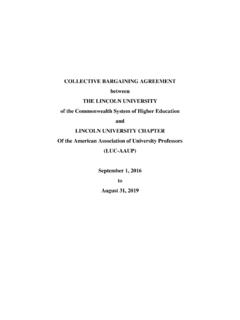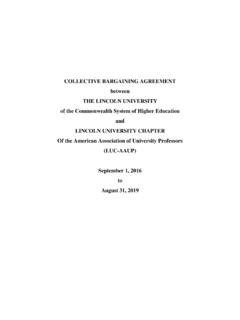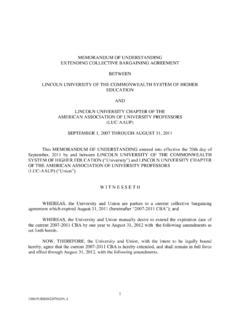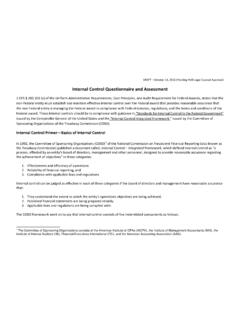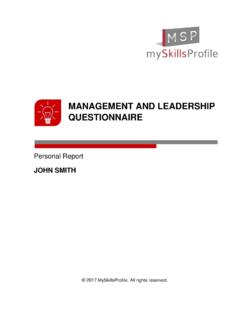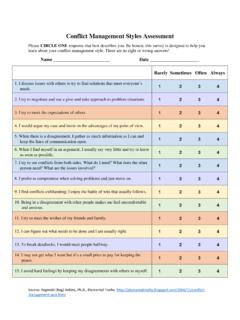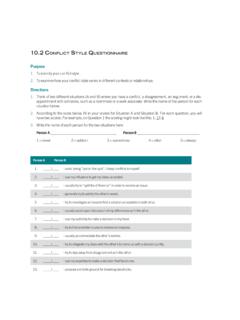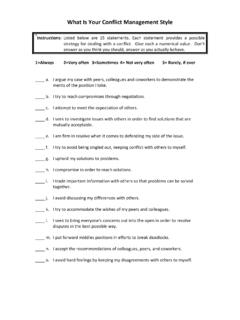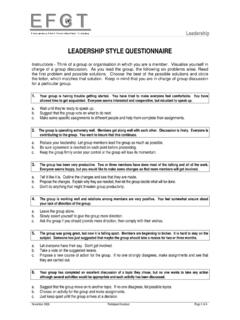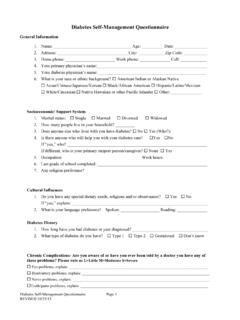Transcription of Conflict Management Styles - Lincoln University
1 Conflict Management Styles Adapted by Crystal Terhune from: OWL Collaborating I win, you win Owls highly value their own goals and relationships. They view Conflict as a problem to be solved and to seek solution that achieves both their goals and the goals of the other person. Owls see conflicts as a means of improving relationships by reducing tensions between two persons. They try to begin a discussion that identifies the Conflict as a problem. By seeking solutions that satisfy both themselves and the other person, owls maintain the relationship. Owls are not satisfied until a solution is found that achieves their goals and the other person s goals. They are not satisfied until the tensions and negative feelings have fully resolved. Turtle Avoiding I zig, you zag Turtles withdraw into their shells to avoid conflicts.
2 They give up their goals and relationships, they stay away from the issues over which the Conflict is taking place and from the persons they are in Conflict with. Turtles believe it is easier to withdraw from a Conflict than to face it. Shark Competing I win, you lose Sharks try to overpower opponents by forcing them to accept their solution to the Conflict . Their goals are highly important to them, and relationships are of minor importance. They seek to achieve their goals at all costs. They are not concerned with the needs of others and do not care if others like or accept them. Sharks assume that conflicts are settled by one person winning and one person losing. They want to be a winner. Winning gives sharks a sense of pride and achievement. Losing gives them a sense of weakness, inadequacy and failure. They try to win by attaching, overpowering, overwhelming, and intimidating.
3 Teddy Bear Accommodating I lose, you win To Teddy Bears, the relationship is of great importance while their own goals are of little importance. Teddy Bears want to be accepted and liked by others. They think that Conflict should be avoided in favor of harmony and that people cannot discuss conflicts without damaging relationships. They are afraid that if the Conflict continues, someone will get hurt and that would ruin the relationship. Teddy Bears say I ll give up my goals and let you have what you want, in order for you to like me. Teddy Bears try to smooth over the Conflict out of fear of harming the relationship. Fox Compromising You bend, I bend Foxes are moderately concerned with their own goals and their relationship with others. Foxes seek a compromise; they give up part of their goals and persuade the other person in a Conflict to give up part of their goals.
4 They seek a Conflict solution in which both sides gain something; the middle ground between two extreme positions. They are willing to sacrifice part of their goals and relationships in order to find agreement for the common good. The Leadership Center At Washington State University D:\My Documents\Websites\lead\library\resource s\RESOURCES\ Conflict Resolution\ Conflict - Management 1 Conflict - Management Style In this section you will have the opportunity to examine your own Conflict - Management style and techniques you tend to use in Conflict situations, particularly under stress. The exercises that follow will enable you to gain insight in to strategies you might choose to incorporate into your behavior in handling disputes and differences. Conflict - Management Style Survey* This Conflict - Management Style Survey has been designed to help you become more aware of your characteristic approach, or style, in managing Conflict .
5 In completing this survey, you are invited to respond by making choices that correspond with you typical behavior or attitudes in Conflict situations. Section 1: Survey This survey identifies twelve situations that you are likely to encounter in your personal and professional lives. Please study each situation and the five possible behavioral responses or attitudes carefully and then allocate ten points between them to indicate your typical behavior, with the highest number of points indicating you strongest choice. Any response can be answered with from zero to ten points, as long as all five responses for a given situation add up to ten points, as shown in the following example: EXAMPLE SITUATION: In responding to a request from another for help with a problem, you would: 4 A. Clearly instruct him or her how to proceed. 2 B. Enjoy the strategizing and the challenge.
6 3 C. Help him or her take responsibility for the problem. 1 D. Find it unnerving but agree to help. 0 E. Avoid the invitation at all costs. 10 TOTAL Please choose a single frame of reference ( , work-related conflicts, family conflicts, social conflicts) and keep that frame of reference in mind when responding to all the situations. And remember, as you complete this survey, that it is not a test. There are no right or wrong responses. They survey will be helpful to you only to the extent that your responses accurately represent your characteristic behavior or attitudes. SITUATION 1: Upon experiencing strong feelings in a Conflict situation, you would: _____ A. Enjoy the emotional release and sense of exhilaration and accomplishment. _____ B. Enjoy the strategizing involved and the challenge of the Conflict . _____ C.
7 Become serious about how others are feeling and thinking. _____ D. Find it frightening because you do not accept that differences can be discussed without someone s getting hurt. _____ E. Become convinced that there is nothing you can do to resolve the issue. TOTAL *Based on Jay Hall s Conflict Management Survey: A Survey of One s Characteristic Reaction to and Handling of Conflict Between Himself and Others (The Woodlands, Texas: Telemetrics International 1969)> The Leadership Center At Washington State University D:\My Documents\Websites\lead\library\resource s\RESOURCES\ Conflict Resolution\ Conflict - Management 2 SITUATION 2: Consider the following statements and rate them in terms of how characteristic they are of your personal beliefs: _____ A. Life is conquered by those who believe in winning. _____ B. Winning is rarely possible in Conflict . _____ C.
8 No one has the final answer to anything, but each has a piece to contribute. _____ D. In the last analysis, it is wise to turn the other cheek. _____ E. It is useless to attempt to change a person who seems locked into an opposing view. TOTAL SITUATION 3: What is the best result that you expect from Conflict ? _____ A. Conflict helps people face the fact that one answer is better than others. _____ B. Conflict results in canceling out extremes of thinking so that a strong middle ground can be reached. _____ C. Conflict clears the air and enhances commitment and results. _____ D. Conflict demonstrates the absurdity of self-centeredness and draws people closer together in their commitment to each other. _____ E. Conflict lessens complacency and assigns blame where it belongs. TOTAL STIUATION 4: When you are the person with the greater authority in a Conflict situation, you would: _____ A.
9 Put it straight, letting the other know your view. _____ B. Try to negotiate the best settlement you can get. _____ C. Ask to hear the other s feelings and suggest that a position be found that both might be willing to try. _____ D. Go long with the other, providing support where you can. _____ E. Keep the encounter impersonal, citing rules if they apply. TOTAL SITUATION 5: When someone you care for takes an unreasonable position, you would: _____ A. Lay it on the line, telling him or her that you don t like it. _____ B. Let him or her know in casual, subtle ways that you are not pleased; possibly distract with humor; and avoid a direct confrontation. _____ C. Call attention to the Conflict and explore a mutually acceptable solution. _____ D. Try to keep your misgivings to yourself. _____ E. Let you actions speak for you by indicating depression or lack of interest.
10 TOTAL SITUATION 6: When you become angry at a friend or colleague, you would: _____ A. Just explode without giving it much thought. _____ B. Try to smooth things over with a good story. _____ C. Express your anger and invite him or her to respond. _____ D. Try to compensate for your anger by acting the opposite of what you are feeling. _____ E. Remove yourself from the situation. TOTAL The Leadership Center At Washington State University D:\My Documents\Websites\lead\library\resource s\RESOURCES\ Conflict Resolution\ Conflict - Management 3 SITUATION 7: When you find yourself disagreeing with other members of a group on an important issue, you would: _____ A. Stand by your convictions and defend your position. _____ B. Appeal to the logic of the group in the hope of convincing at least a majority that you are right. _____ C. Explore points of agreement and disagreement and the feelings of the group s member, and then search for alternatives that take everyone s views into account.


